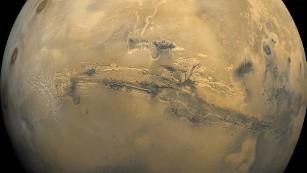CNN, May 10, 2016 – NASA’s Curiosity Mars rover took this January 19, 2016, selfie while sitting at “Namib Dune.” The rover was scooping up sand from the dune to analyze. The photo combines 57 images taken during the rover’s 1,228th Martian day, or Sol. The photos were taken at the end of the rover’s robotic arm.
Hide Caption

Atomic oxygen can help scientists determine atmospheric erosion and how other gases escape Mars. It also affects the radiative cooling from the carbon-dioxide bands in the Martian thermosphere, which is above the mesosphere.

The spectrum of oxygen superimposed on an image of Mars from the MAVEN mission.
The atomic oxygen discovery was made using an instrument on board the Stratospheric Observatory for Infrared Astronomy, or SOFIA. SOFIA is a Boeing 747SP jet that has been modified for research purposes to carry a 100-inch diameter telescope.
Expandable habitats may take us to Mars
Detecting atomic oxygen in the Martian atmosphere has been difficult in the past, such as on the Viking and Mariner missions of the 1970s, because researchers weren’t able to measure accurately the wavelengths associated with it.

Mars and Earth are getting closer (for now)
The last attempt at observing atomic oxygen in the Martian atmosphere was 40 years ago.
The SOFIA jet was able to fly between 37,000 feet to 45,000 feet above the moisture in Earth’s atmosphere that blocks infrared wavelength detection. Doing so allowed the SOFIA team, working with the German Aerospace Center, to observe the far-infrared wavelengths.
Using the German Receiver for Astronomy at Terahertz Frequencies, known as GREAT, allowed researchers to distinguish between oxygen from our atmosphere and that of the Martian atmosphere.
They discovered half the amount of atomic oxygen expected, most likely due to variations in the atmosphere itself, and scientists will continue to use SOFIA to study the Martian atmosphere.
The findings were presented in the journal Astronomy and Astrophysics.








